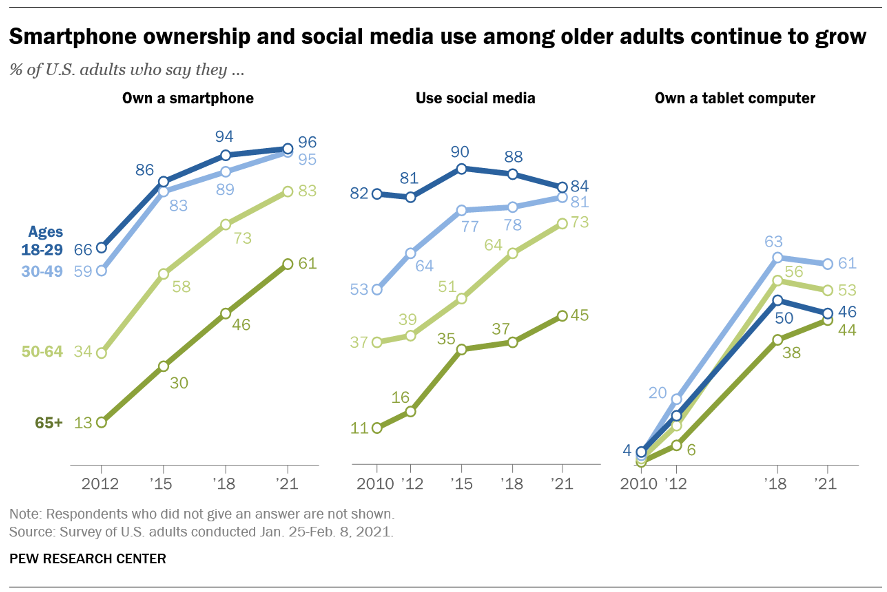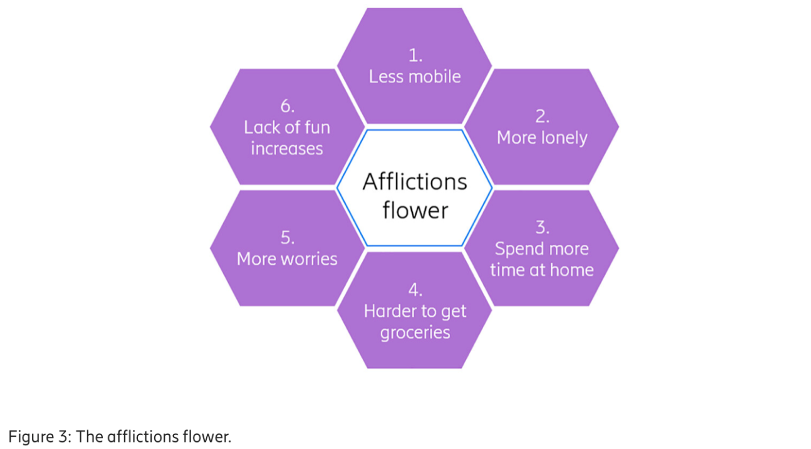“Working Differently” with the Aging Population to Improve Health Outcomes
[Author:
ALLISON CUTTS | Executive Director, Business Development and Sales – Patient Support Solutions]
Caring for older populations is an ongoing evolving opportunity for patients, providers, pharmaceutical companies, and healthcare organizations building patient support programs to engage the 65+ population to support healthcare needs.
Historically, there have been perceptions that aging populations may be less inclined to adopt digital health and patient programs using technology and smart devices. Data over the past few years indicates that this cohort is narrowing the gap in comparison to younger adults in the use of smartphones and social media.
Technology and the Aging Population
In January 2022, the Pew Research Center’s research indicated that the 65 and older population has grown in the past decade, and this age group’s growth in use of technology represented 61% of US adults owning Smartphones, 45% use of social media platforms, and 44% as owners in tablets.

The growth in seniors’ adoption of technology is because every year new, more digitally experienced seniors are replacing older seniors falling outside the upper limit of the age interval.
Many of these ‘new seniors’ have had a previous digital experience in their careers and/or are encouraged by family and friends to socialize and stay connected using smartphones and other devices.
In addition, we all know the COVID-19 crisis had a large impact on seniors. In a January 2021 article, Ericsson’s COVID “Afflictions flower” describes risk areas that can negatively impact the older population. However, many seniors combatted these issues through technology, as they used and are continuing to use the internet more and more to stay connected digitally with family and friends, to work remotely, and to carry on daily activities.

A 2020 AARP article, Older Adults Keep Pace on Tech Usage, provided various health and wellness technology trends gathered from market research, which showed that seniors recognize the benefits of technology aiding in tracking their health virtually to reach health goals. Forty percent of respondents indicated they were interested in using technology to help them with medication reminders and to communicate with their healthcare providers. Twenty-one percent of those surveyed had interest in video conferencing as part of their care. Overall, 53% of the senior population interviewed prefer a mix of on-site clinical care combined with digital health technologies.
Improving Health Outcomes for the Aging Population
Pharmaceutical companies, healthcare providers, payers, and other support organizations are all exploring new and better ways to help older patients improve disease education, engagement in care, and clinical outcomes.
To support these efforts, Medocity, an innovative, patient-focused health technology company, offers digital solutions to empower, connect and educate seniors. Our user-friendly programs engage patients throughout their disease journey and enable the capture of continuous patient-centered data. Accessible on any device, our technology is extremely interoperable, seamlessly integrating hundreds of connected sensors and wearables, data sources, systems, and vendors, to provide a digital ecosystem of care 24/7. Medocity’s solutions increase retention and compliance, improve outcomes, and lower healthcare costs.
The Medocity Platform’s integrated, end-to-end solution uniquely enables the following key capabilities to enable patient support programs for seniors:
- Personalized guided sessions to collect data through a wizard-like experience, simplifying patient’s tasks, increasing engagement, assisting with behavioral modifications, and prompting educational guidance on correlation of key actionable data
- Real-time data capture and actionable alerts individualized to patients’ current and ongoing care needs
- Universal access and seamless connectivity for all stakeholders, which creates a digitally integrated ecosystem of patients, healthcare providers, caregivers, pharmacies, hub programs, support organizations, and/or labs, etc.
- Remote monitoring, real-time intelligence, and meaningful interventions to track key vital signs, behavioral patterns and needs to ensure improved patient engagement and medication adherence
- Curated resources for patients and caregivers with timely screening for behavioral modification and prompt educational guidance
- Proactive and predictive nudges to achieve fewer or less severe disease state complications
- Clinically and commercially validated high patient engagement and satisfaction rates to align with ongoing goals, expansion of care, and social support programs
- Real-time patient reminders to improve reporting compliance and medication adherence
Medocity’s truly patient-centric platform creates a full continuum of care to support seniors simply and elegantly with a personalized, interactive experience throughout their care journey.
To learn more about how Medocity is helping life science companies to “Work Differently” with our digital patient-centric connected ecosystems, contact Allison Cutts at acutts@medocity.com.
—————————–
Reference Articles:
[1] Pew Research Center: https://www.pewresearch.org/fact-tank/2022/01/13/share-of-those-65-and-older-who-are-tech-users-has-grown-in-the-past-decade/
[2] Ericsson: Seniors and technology during Covid-19: the latest insights: https://www.ericsson.com/en/blog/2021/1/seniors-and-technology-during-covid
[3] AARP: Older Adults Keep Pace on Tech Usage: https://www.aarp.org/research/topics/technology/info-2019/2020-technology-trends-older-americans.html